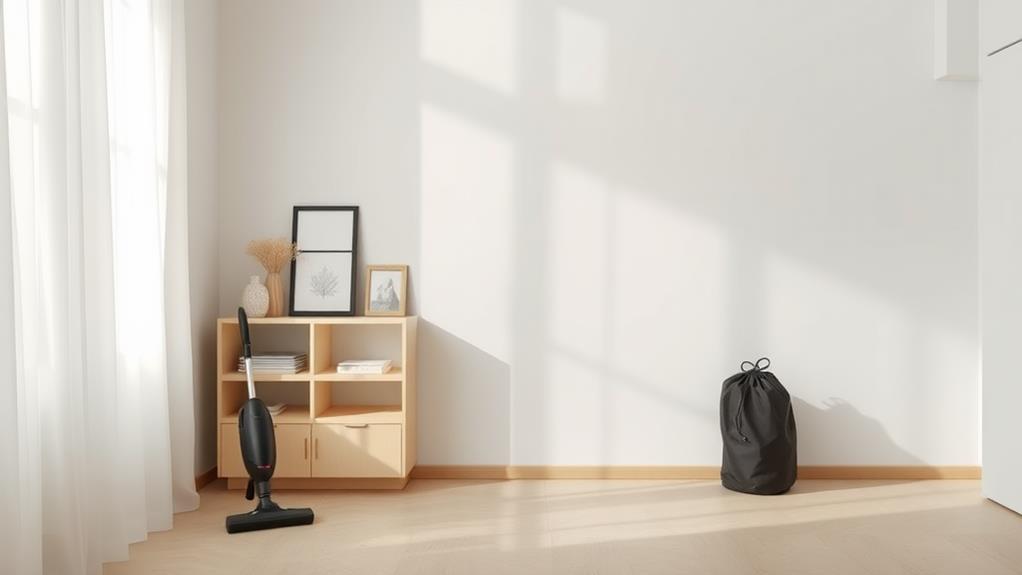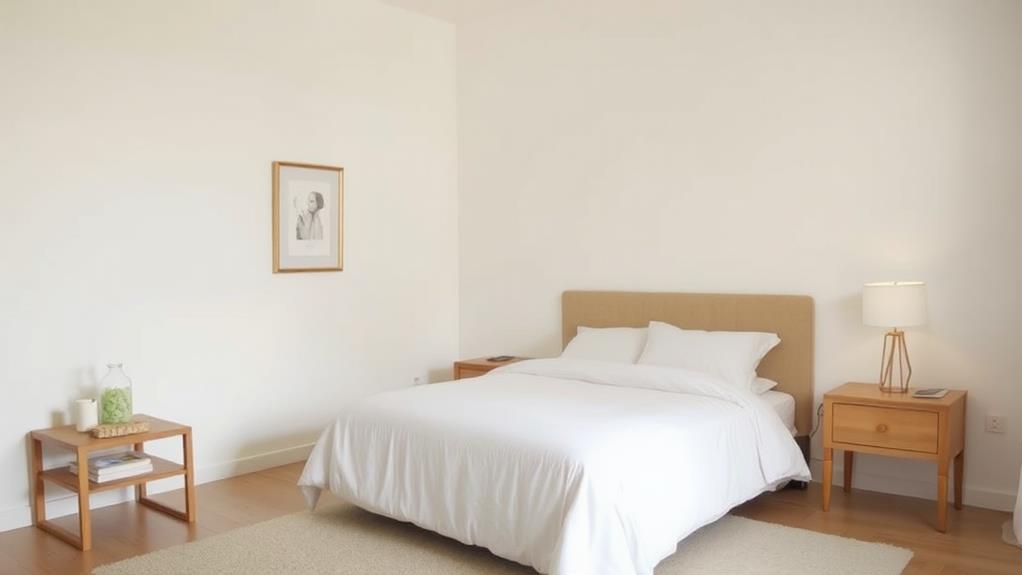You're ready to break free from the burden of clutter and transform your living space into a haven of calmness and productivity. Start by adopting a decluttering mindset, focusing on the benefits of a clutter-free space. Visualize the extra time and money saved by avoiding impulse buys and reducing waste. Next, sort items into categories like "keep," "donate," and "recycle," and be ruthless about getting rid of anything broken, outdated, or no longer serving a purpose. As you tackle each area, you'll start to see progress and gain momentum – and that's just the beginning of your decluttering journey.
Summary
- Adopt a decluttering mindset, focusing on the benefits of a clutter-free space to stay motivated and visualize the end result.
- Implement effective sorting strategies by creating a category system, dividing items into "keep," "donate," "sell," and "recycle" to make quick decisions.
- Focus on one area at a time, removing everything and putting back only what brings joy or serves a purpose to create a peaceful, organized space.
- Designate a specific spot for each item, labeling each station to avoid confusion and encourage respect for the system, making it easy to find and put back what is needed.
- Remove clutter before organizing what's left, using strategies like the "one-touch rule" to make quick decisions and maintain momentum throughout the process.
Prepare for Decluttering Success
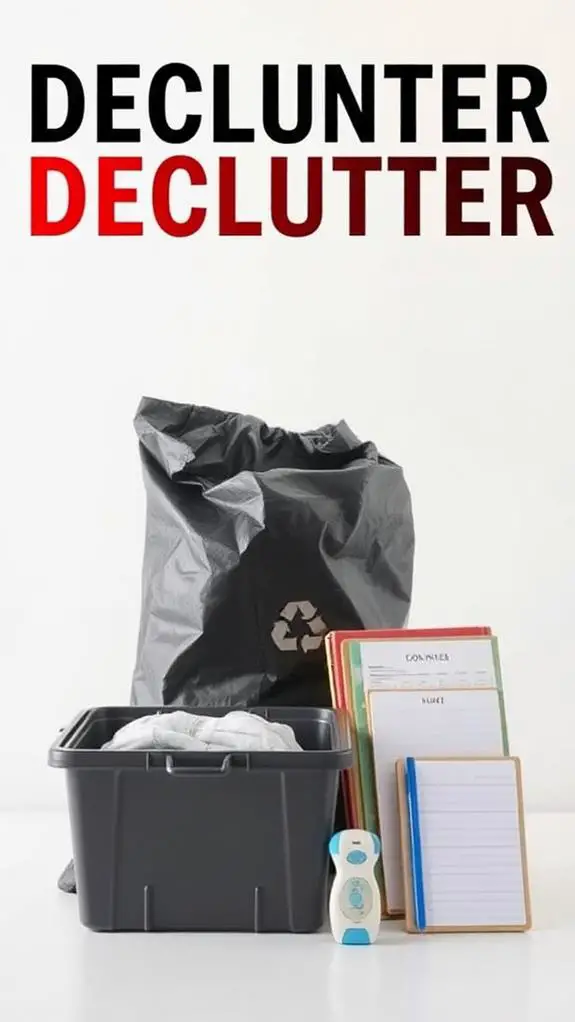
Get ready to plunge into the decluttering process by setting yourself up for success.
Adopt a decluttering mindset, focusing on the benefits of a clutter-free space. Imagine the sense of calm and clarity you'll experience once your home is organized.
Visualize the extra time you'll have, free from searching for lost items or cleaning around clutter. Envision the money you'll save by avoiding impulse buys and reducing waste.
With a clear vision of your goals, you'll stay motivated throughout the process. Take a few minutes to reflect on what's driving you to declutter and what you hope to achieve.
Write down your goals and post them somewhere visible to remind yourself of the benefits you'll enjoy once you've achieved a clutter-free home.
Sort Items Into Categories

You've set your decluttering goals and are motivated to achieve a clutter-free space.
Now it's time to sort items into categories. This vital step helps you understand what you have, what you need, and what you can let go of.
Implement effective sorting strategies by creating a category system that works for you. Divide items into broad categories like "keep," "donate," "sell," and "recycle."
Then, break down each category into subcategories, such as "keep: clothing" or "donate: books." This system helps you make quick decisions and prevents clutter from building up again.
With a clear category system in place, you'll be able to make the most of your decluttering efforts.
Purge Unwanted Items Fast
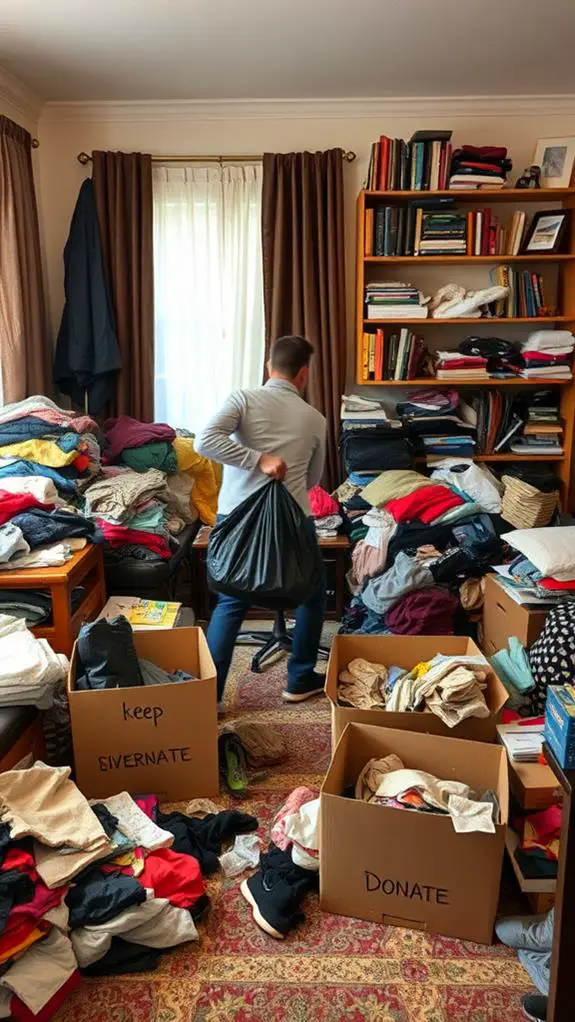
You're now ready to tackle the most pivotal step in decluttering: purging unwanted items.
This is vital to be ruthless and get rid of anything that's broken, outdated, or no longer serves a purpose.
Get Rid of Clutter
As you stand amidst the chaos, clutter overwhelming every corner of your home, it's clear that something needs to change.
It's time to adopt a Clutter Free Mindset and commit to a Clutter Free Lifestyle.
Start by gathering boxes and bags, and sort items into three piles: keep, donate/sell, and discard.
Be ruthless – if you haven't used it in a year, it's likely you won't miss it.
Focus on one area at a time, like your closet or kitchen counters.
Remove everything, and then put back only what brings you joy or serves a purpose.
Remember, the goal is to create a peaceful, organized space that sparks productivity and calmness.
Don't Get Sentimental
The clock is ticking, and it's time to purge unwanted items fast.
You've got to be ruthless when decluttering – emotional attachment can be a major obstacle. It's natural to hold onto items that evoke past memories, but crucial to distinguish between sentimental value and clutter.
Ask yourself, "Do I really need this item, or am I just holding onto it out of nostalgia?" Be honest with yourself, and let go of items that no longer serve a purpose.
Organize Your Decluttering Space
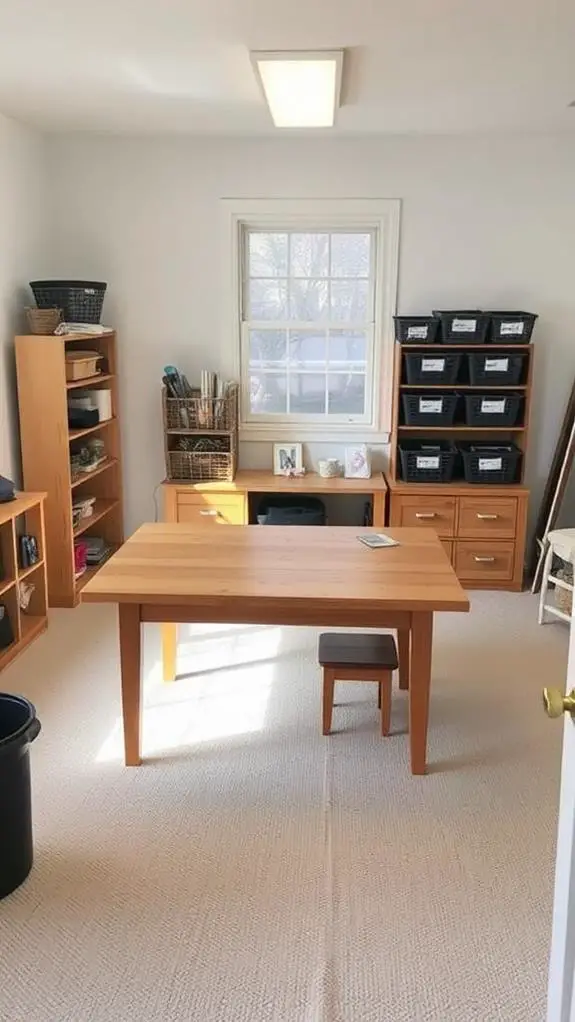
You're ready to tackle the decluttering process, but first, you need to organize your workspace.
Start by clearing the clutter zone, designating a specific area for sorting and categorizing items, and preparing the essential tools you'll need to get the job done.
Clear the Clutter Zone
About 80% of your decluttering success depends on having a well-organized workspace, which we'll call the Clutter Zone.
This space should be dedicated to tackling clutter, free from distractions and interruptions.
Clear the Clutter Zone by removing any items that aren't essential to the decluttering process.
This includes clutter triggers like magazines, phones, or TVs that might divert your attention.
Having a dedicated space helps you stay focused and maintain momentum.
Designate a specific area for sorting, categorizing, and decision-making.
This will help you stay organized and guarantee that you're making progress towards your decluttering goals.
Designate a Workspace
Designating a workspace that's tailored to your decluttering needs is essential for staying focused and efficient.
This work station will serve as your command center, helping you tackle the task at hand. Set up a declutter zone where you can sort, categorize, and purge items.
Consider the layout of your space and allocate areas for different tasks, such as a "keep" zone, a "donate" zone, and a "recycle" zone.
Having a dedicated workspace will help you stay organized, avoid distractions, and maintain momentum throughout the decluttering process.
Prepare Essential Tools
With your decluttering workspace set up, it's time to equip yourself with the essential tools needed to tackle the task at hand.
First, create a decluttering checklist to guide you through the process and help you stay focused.
Next, gather labels and a marker to categorize and identify items as you sort them.
You'll also need sturdy boxes or bins to store items you're keeping, as well as trash bags for items you're discarding.
Don't forget a dustpan and broom to clean up any messes, and a timer to keep yourself on track.
Having these tools at your disposal will guarantee a smooth and efficient decluttering process.
Tackle Clutter Hotspots First
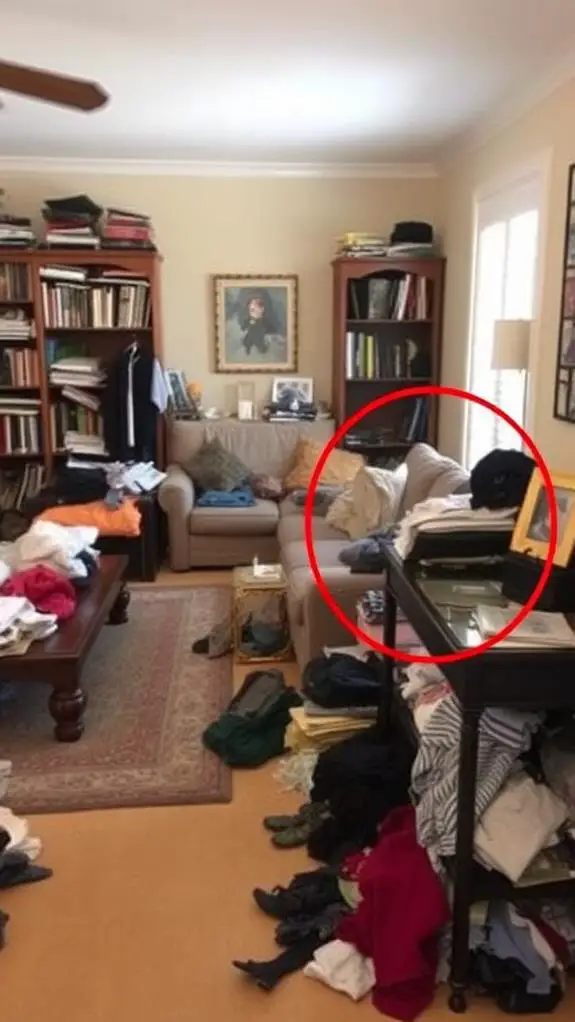
You stand in front of your cluttered house, feeling overwhelmed by the sheer amount of stuff that needs to be sorted through.
To get started, focus on tackling clutter hotspots first. Identify areas that bother you the most, like the entryway or kitchen countertops.
These hotspot areas tend to accumulate clutter quickly, making them ideal starting points. Break down each clutter zone into smaller sections, and sort items into categories like "keep," "donate," and "discard."
Declutter Room by Room
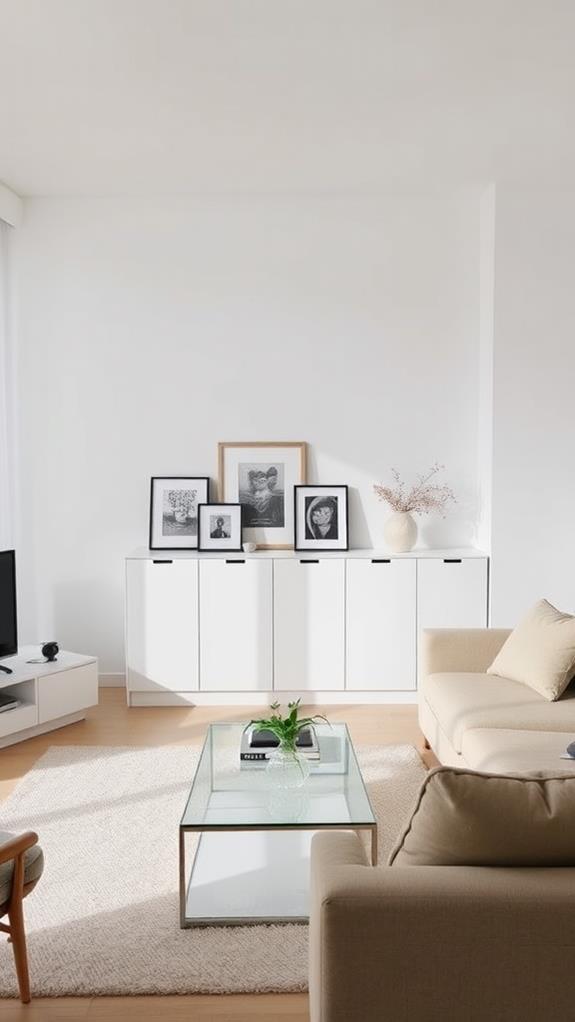
This decluttering process gains momentum as you move from tackling clutter hotspots to decluttering room by room.
Now, it's time to transform your entire space. Adopt a decluttering mindset, and envision each room refreshed and revitalized.
Start with one room, and work your way through it, sorting items into categories like keep, donate, and discard.
Focus on one area at a time, like a bookshelf or dresser, to maintain a sense of control.
As you declutter, ask yourself if each item sparks joy or serves a purpose.
Be ruthless – if it doesn't, let it go.
With each room refresh, you'll feel a sense of accomplishment and motivation to continue the process.
Create a Home for Everything

Your newly decluttered rooms now need a system to maintain their organization.
Assign a Home Station for each item, making it easy to find and put back what you need. This designated spot becomes an Item Haven, where everything has a purpose and a place.
Label each station to avoid confusion and encourage family members to respect the system. For example, designate a spot near the entrance for keys, wallets, and bags, or create a station for mail and bills.
This system helps maintain order and saves time searching for misplaced items. By creating a home for everything, you'll be more efficient and enjoy your decluttered space.
Simplify Your Paper Clutter
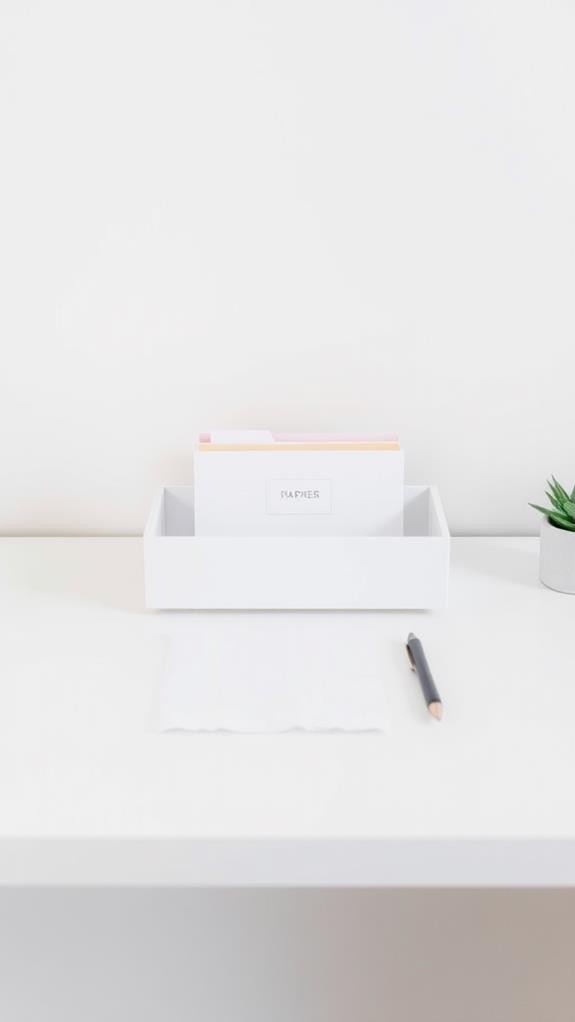
Paper clutter can be overwhelming, especially when it's scattered throughout the house.
It's time to take control of those paper trails and create a system that works for you.
Start by gathering all your papers and sorting them into categories, such as bills, receipts, and documents.
Next, set up a filing system that's easy to maintain.
Designate a specific spot for your files, like a file cabinet or a digital storage drive.
Create folders and labels to keep everything organized.
Consider digitizing your papers to free up physical space.
Let Go of Sentimental Items
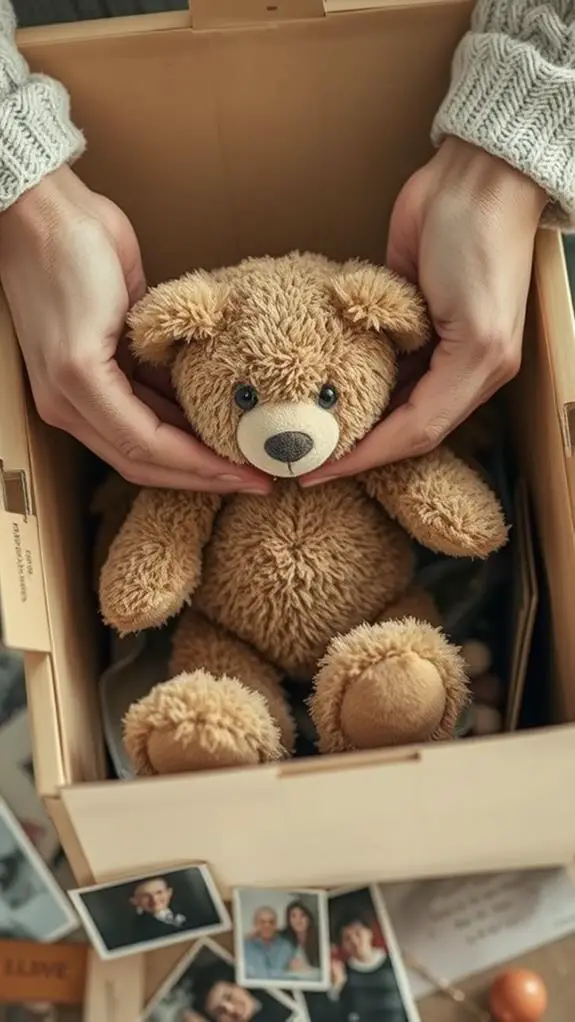
Hundreds of sentimental items, from childhood trinkets to family heirlooms, can clutter your home and weigh you down emotionally.
You're not alone in struggling to part with these items, as they often hold memories attached and emotional value. Crucial to recognize is that the memories and emotions aren't in the item itself, but in your mind and heart.
Ask yourself if keeping the item truly honors the memory or if it's just holding you back. Be honest, and you might be surprised by how many items you can let go of.
Take photos of items you want to remember but don't need to keep, and create a digital archive. This way, you'll still have the memories without the clutter.
Donate or Sell Unwanted Items
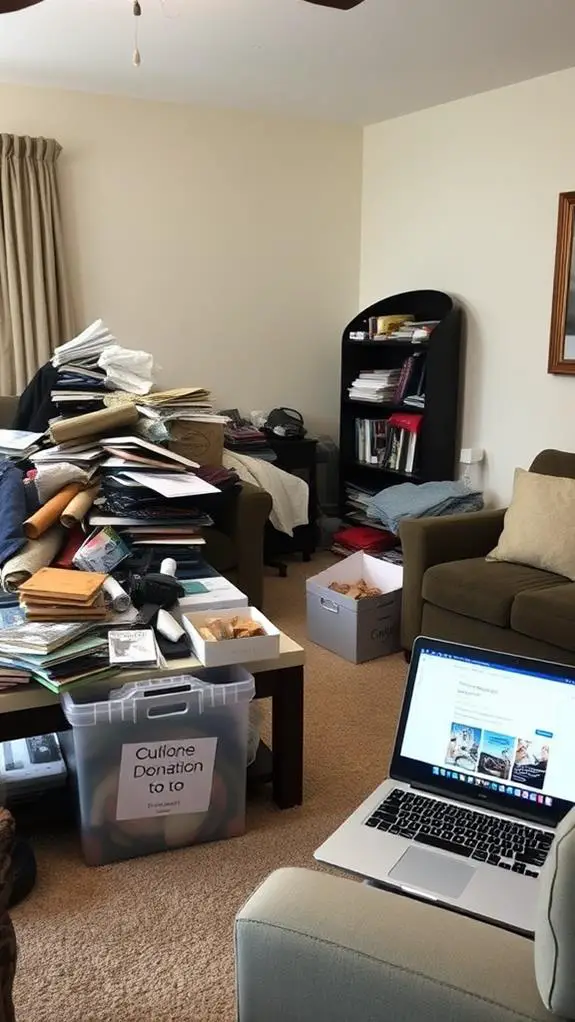
With your newly decluttered space in mind, it's time to decide what to do with the items you've set aside.
You've got two main options: donate or sell. Consider donating gently used items to charity options like Goodwill, Habitat for Humanity ReStores, or local thrift shops.
You'll be supporting a good cause and might even get a tax deduction. If you'd rather make some extra cash, try selling items on online marketplaces like eBay, Craigslist, or Facebook Marketplace.
Take clear photos, set competitive prices, and write honest descriptions to attract buyers. You can also hold a yard sale or garage sale to get rid of multiple items at once.
Whatever you choose, get rid of these items quickly to avoid cluttering up your newly decluttered space.
Clean as You Declutter
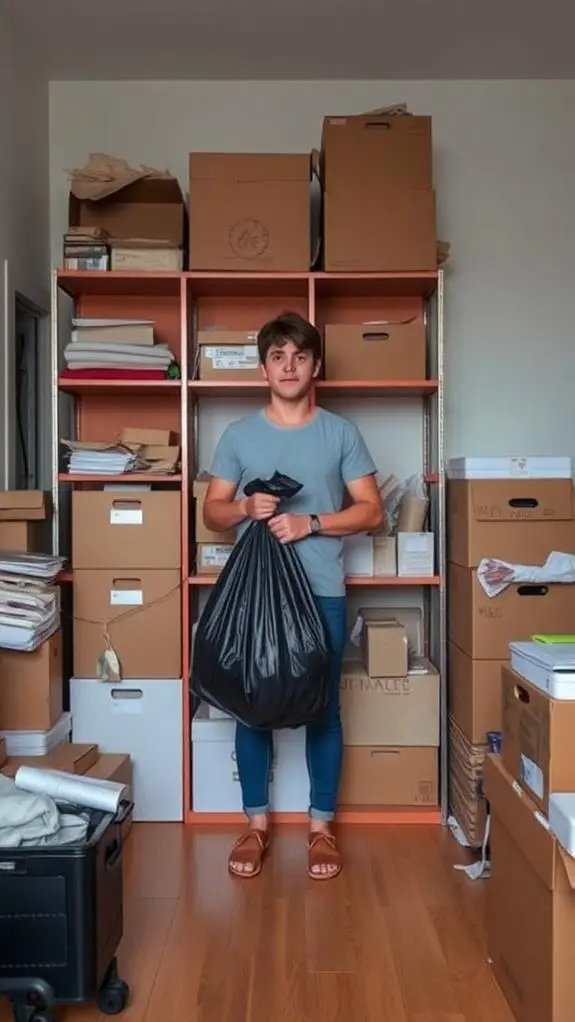
As you start decluttering, remember to remove the clutter first before organizing what's left.
This approach helps you see what you're working with and prevents you from wasting time organizing items you'll eventually get rid of.
Remove the Clutter First
You've got a monumental task ahead of you: tackling the overwhelming clutter that's taken over your space.
To make progress, adopt a decluttering mindset, focusing on removal before organization. Start by gathering supplies like trash bags, donation boxes, and a label maker.
Then, plunge into each room, sorting items into categories: keep, donate, sell, and discard. Be ruthless – if you haven't used it in a year, it's probably safe to let it go.
Use clutter removal strategies like the "one-touch rule" to make quick decisions and avoid re-handling items.
As you remove the clutter, you'll begin to see your space transform, and your mindset will shift from overwhelmed to empowered.
Organize as You Go
Your decluttered space is taking shape, and now it's time to bring order to the chaos.
As you declutter, organize items into categories, and assign a home for each group. This way, you'll maintain your progress and prevent clutter from building up again.
Develop daily habits like putting things back in their designated spots after use. Practice constant vigilance to guarantee everything stays organized.
Set aside time each day to maintain your space, even if it's just for a few minutes. By doing so, you'll create a system that's easy to follow and maintain, certifying your newly decluttered space remains clutter-free.
Maintain Your Clutter-Free Space
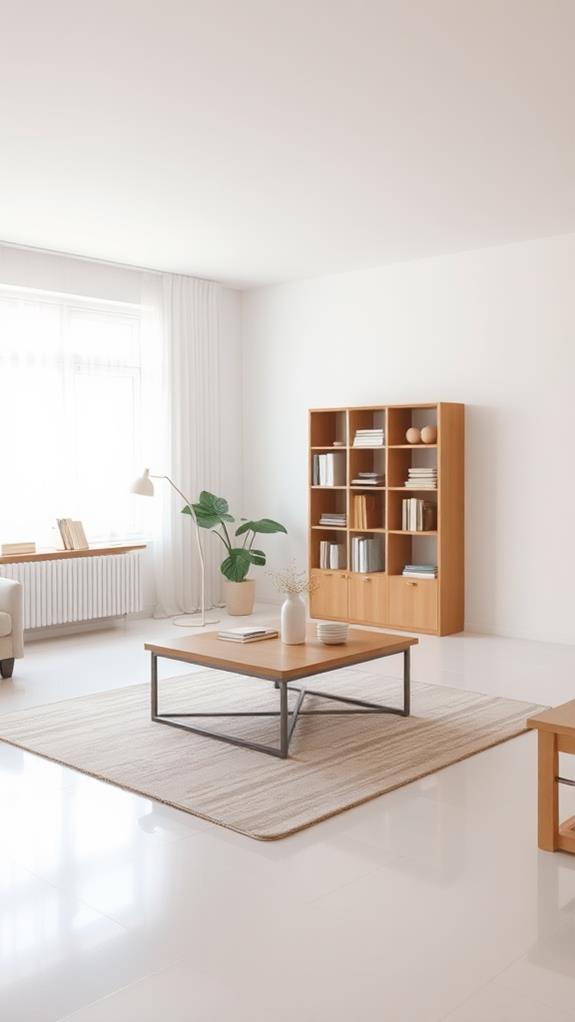
Now that you've decluttered your space, it's vital to maintain the order and organization you've achieved.
To do this, establish daily habits that support your new clutter-free lifestyle. Set aside time each day to tidy up, putting away items that are out of place.
Create a routine for tasks like laundry and cleaning to guarantee they don't pile up.
For long-term goals, consider implementing a "one in, one out" policy to prevent clutter from accumulating again.
You can also schedule regular decluttering sessions to maintain your space.
FAQs
How Do I Get My Family Members to Help With Decluttering?
You'll get your family members on board by acknowledging their individual perspectives and assigning tasks that play to their strengths, fostering a sense of shared responsibilities and healthy family dynamics that encourage teamwork and collaboration.
What if I'm Overwhelmed by the Emotional Attachment to Items?
When surrounded by sentimental value, you're really holding onto emotional baggage. You're not just decluttering stuff, you're confronting memories. Take a deep breath, acknowledge the feelings, and ask yourself: what's the real value – the memory or the item itself?
Can I Declutter if I Have a Small Living Space?
You can thrive in small spaces, embracing micro living's efficiency. Start by prioritizing essentials, storing items out of sight, and utilizing vertical space to create a clutter-free haven that sparks joy and productivity.
How Often Should I Declutter to Maintain a Clutter-Free Home?
To maintain a clutter-free home, you'll want to establish a daily routine of tidying up and scheduling seasonal purges to keep your space organized and refreshed, ensuring your home stays clutter-free and functional.
Are There Any Decluttering Apps or Tools That Can Assist Me?
You're looking for tech-savvy solutions to streamline your decluttering process! Try virtual organizers like Habitica or Decluttr, or decluttering games like ChoreMonster to gamify your tasks – they'll keep you motivated and on track to achieve your decluttering goals!
Conclusion
You've made it! Your house is now decluttered and organized. Pat yourself on the back for tackling the task. Remember, maintenance is key. Set aside time each week to maintain your clutter-free space. Stay vigilant about what comes into your home and be intentional about what you keep. With these habits, you'll enjoy your newly organized space for years to come.

